EU Calculations
Project Defaults EU
A comprehensive guide to setting up project defaults for European design standards, including deflection limits, load combinations, and building geometry
Background
Every ClearCalcs project has an optional button in the sidebar called ‘Project Defaults’. These are a set of default/preset values for the country code in question. They are carried through to every new calculation that is created. The purpose of this tutorial is to clarify the use of these defaults, and which calculators are impacted by each option. Tip: You can still override any of these defaults in a specific calculator by selecting the field in question and manually typing over it. These defaults are purely to save you time, and you don’t need to use them if you don’t want to. If you copy a project, any project defaults will be copied along with the calculations. The main sections in Project Defaults are:- Deflection Limits (EN 1990:2002 A1.4)
- Building geometry (e.g. beam spacings, storey heights, roof slope)
- Default Loads (e.g. default roof, floor, wall & window loads)
- Load Combinations & Factors (e.g. Strength & Serviceability Combinations)
1. Deflection Limits (EN 1990:2002 A1.4)
1(A) Absolute Deflection Limits
Some hard limits are provided in the Project Defaults which may override any deflection limit above. Of course you can always override these values in any of the calculators.
1(B) Timber / Steel Deflection Limits
Deflection limits may be set once within Project Defaults, and then every calculator you create / have created will inherit these values. Of course you can always override these values in any of the calculators. Timber columns are checked for the Instantaneous Deflection and Final Deflection (net). ClearCalcs does not support beam pre-camber. Steel columns are typically checked for the Characteristic Deflection Limits only, however both the Frequent and Quasi-Permanent inputs are provided, if required by client and/or national annexes.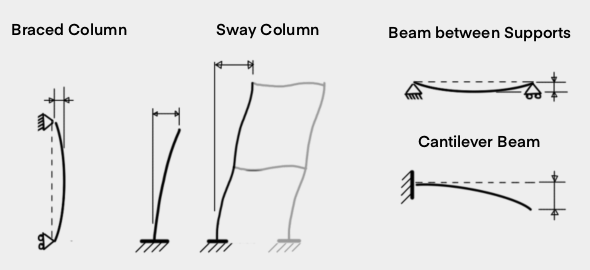

2. Building Geometry
2(A) Storey / Ceiling & Window Height:
Do you want to set up default heights of each storey of your building? This can be used to create default column lengths every time you create a new calculation Tip: You can find explanatory information & diagrams by expanding any label. For example, expanding “Floor Heights” above shows this:
Tip: You can find explanatory information & diagrams by expanding any label. For example, expanding “Floor Heights” above shows this:
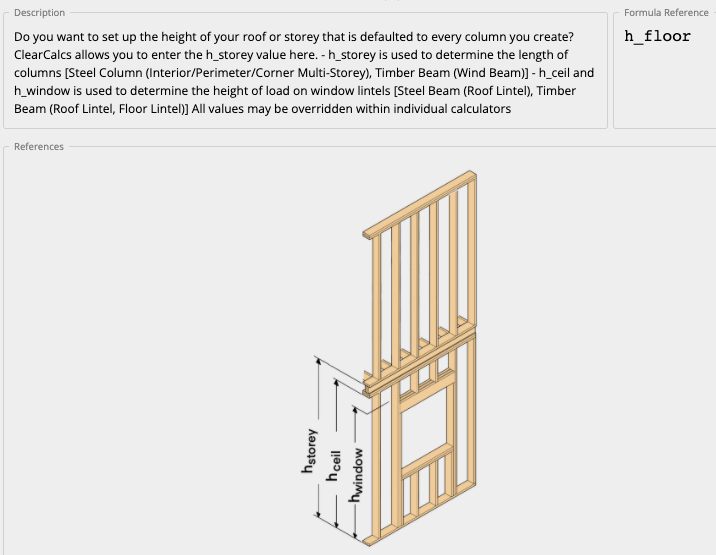
| AFFECTED CALCULATORS |
|---|
| Steel Column (Interior/Perimeter/Corner Multi-Storey, Roof Lintel) |
| Timber Beam (Wind Beam, Roof/Floor Lintel) |
2(B) Rafter / Joist / Stud Spacing
Default spacings used to calculate distributed loads in rafters and joists. Refer to article 170-what-is-tributary-width for details about how distributed loads are calculated.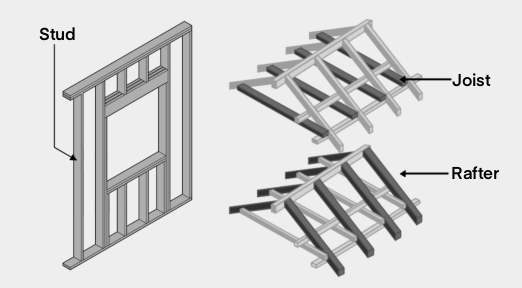
 Quick Tip: Did you know that rafters or joists may be linked into other beams (e.g. floor bearer) as a line load? This means you only have to create a single rafter / joist and then ClearCalcs will use the spacing to regularly space the reactions. Refer for details 24-linking-reactions-between-beams-and-columns-load-path-tracking. Of course the values may be overridden within each calculator. See example from the “Steel Beam” calculator:
Quick Tip: Did you know that rafters or joists may be linked into other beams (e.g. floor bearer) as a line load? This means you only have to create a single rafter / joist and then ClearCalcs will use the spacing to regularly space the reactions. Refer for details 24-linking-reactions-between-beams-and-columns-load-path-tracking. Of course the values may be overridden within each calculator. See example from the “Steel Beam” calculator:
| AFFECTED CALCULATORS |
|---|
| Steel Beam |
| Timber Beam |
2(C) Beam Depth Limits:
Does your structure have space constraints? ClearCalcs will check the depth of your beam, and compare it with the Maximum Roof Beam Depth set below.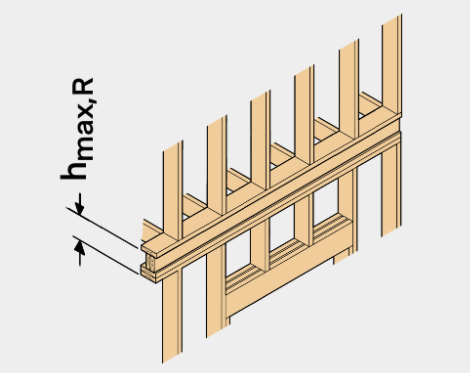

| AFFECTED CALCULATORS |
|---|
| Steel Beam |
| Timber Beam |
2(D) Default Bearing Length (lb)
ClearCalcs performs a bearing check is completed for timber beams. The default bearing length can be set here, however may be overridden in each individual calculation.
| AFFECTED CALCULATORS |
|---|
| Timber Beam |
3. Default Loads (EN 1991-1:2002 Table 6.2)
3(A) Roof and Ceiling Loads:
Roof Roof Default Load Table is dynamically set based on the selection of criteria for “Roof Permanent” and “Roof Imposed” Load selections.
| AFFECTED CALCULATORS |
|---|
| Steel Beam (Rafter, Verandah Beam, Underpurlin, Roof Bearer, Roof Lintel Floor Bearer, Floor Lintel) |
| Wood Beam (Rafter, Verandah Beam, Underpurlin, Roof Bearer, Roof Lintel Floor Bearer, Floor Lintel) |
| AFFECTED CALCULATORS |
|---|
| Steel Beam (Hanging Beam, Ceiling Joist) |
| Timber Beam (Hanging Beam, Ceiling Joist) |
3(B) Floor
Floors have default area loads depending on the structures’ intended use. The “Live Load Selection” is used to set the “Default Floor Loads” details in the dropdown menu.
| AFFECTED CALCULATORS |
|---|
| Steel Beam |
| Timber Beam |
3(C) Wall & Window
Wall Default loads are used on Floor Lintel Calculators. These may be overridden within individual calculators.
4. Load Combinations & Factors
ClearCalcs provides standard Load Combinations & Factors. These can be set to custom values. See below how to select these: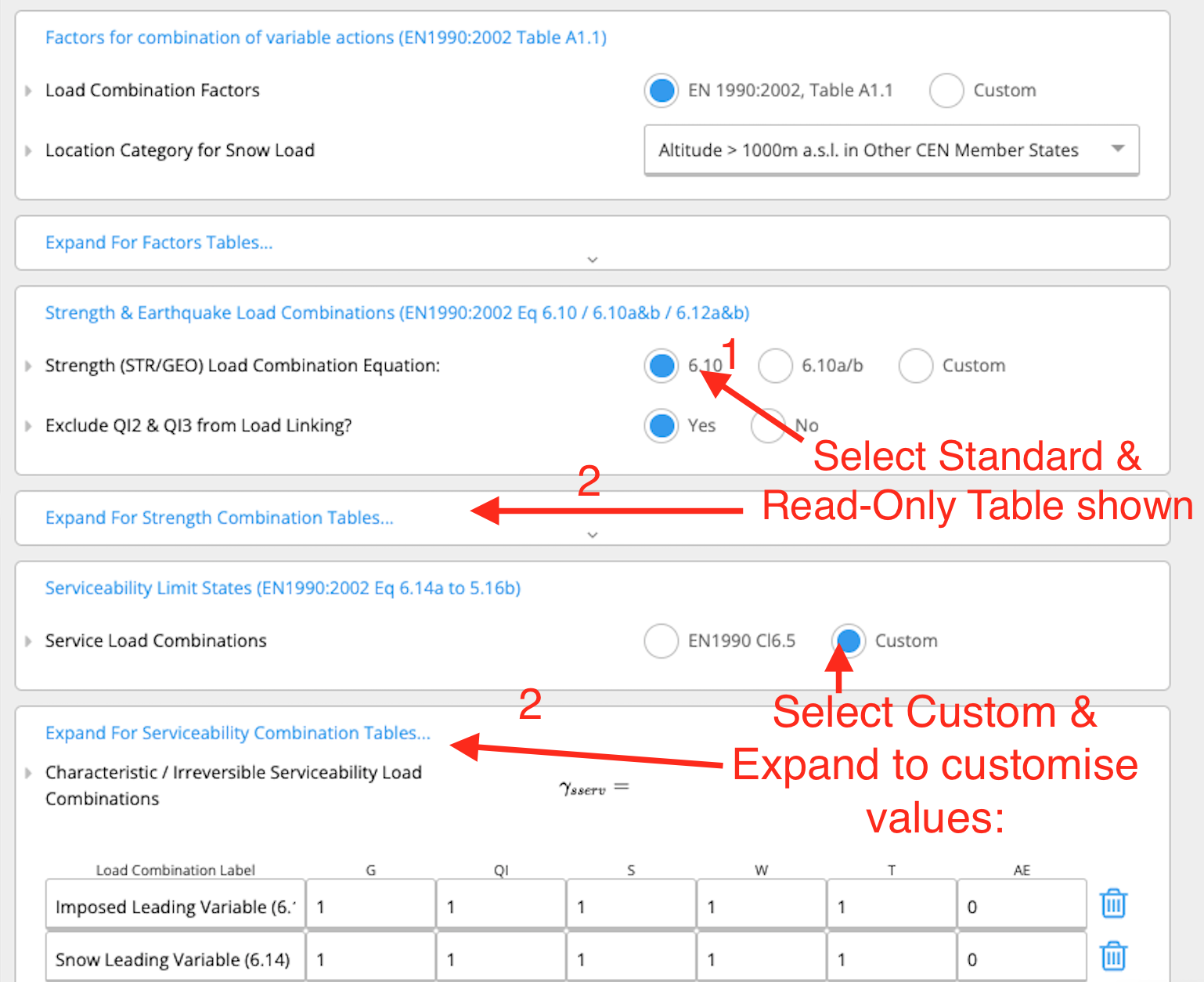
4(A) Factors for combination of variable actions (EN1990:2002 Table A1.1)
The value of the combination factors are defined in EN 1990:200 Table A1.1 - ψ factors for buildings. Eurocode snow location categories can be selected. For National Annexes that use custom snow categories, “Custom” snow factors need to be set instead:
4(B) Strength & Earthquake Load Combinations (EN1990:2002 Eq 6.10 / 6.10a&b / 6.12a&b)
A range of EN 1990:2002 load combinations are provided for Strength and Serviceability. These affect the load combinations in all design calculators (e.g. Timber & Steel Beam/Column). Where EN1990:200 Eq 6.10a/b is used, a choice is given to consider Permanent Load only for equation 6.10(a), and a custom dead load reduction factor ξ may also be chosen:Exclude QI2 & QI3 from Load Linking?
Each calculation has “alternative” live load combinations, which are not intended to be applied at the same time (e.g. during construction imposed load vs post-construction residential loads). These are represented by QI, QI2 and QI3. When linking loads, you can choose to only transfer through the main load (i.e. the alternative construction load does not need to be applied to others part of the structure). Generally this load shouldn’t actually be linked through the load path in the building - it should just be an alternate load for individual members only. Select “Yes” here to exclude these loads from all load linking throughout this project.
4(C) Serviceability Limit States (EN1990:2002 Eq 6.14a to 5.16b)
Service load combinations are provided in EN 1990:2002 Eq (6.14) to (6.16) - characteristic, frequent and quasi-permanent. Each type of material (timber, steel, concrete) treats deflection limits slightly differently. In EN1993 (steel), all 3 deflection combinations are used, although some codes may only require the use of the Characteristic Combination. In EN1995 (timber), “Instantaneous” and “Final” deflection combinations are checked:- Instantaneous either refers to “Characteristic” or “Frequent” Combinations, subject to client and national requirements. This may be adjusted within individual calcualtors.
- Final refers to the “Characteristic” combination of actions, however modified to incorporate the creep deformation factor k_def, in accordance with EN1995-1-1:2004 Cl 2.2.3 (5). An alternative more general method Cl 2.2.3 (3) is not used.

Why would you want to set custom combinations?
- Does your National Annex amended or add to the default load combinations?
- Does your company design to more strict combinations than the code requires?
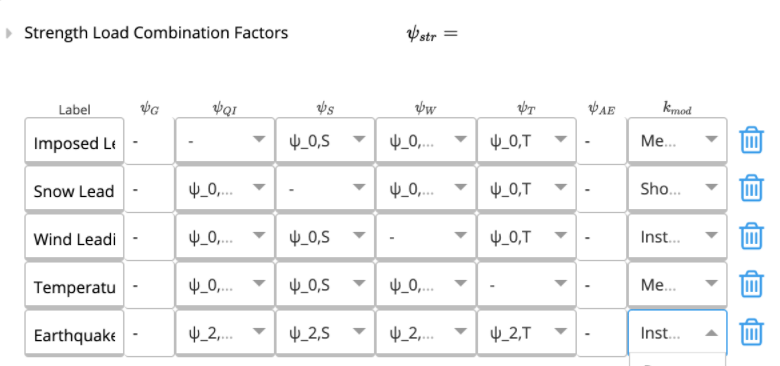 Tip: You can move Project Defaults between projects. Typically customers create a number of template projects that only have Project Defaults, which can be duplicated for each new project!
You have now customised your ClearCalcs project to make creating any calculations quick and easy
Tip: You can move Project Defaults between projects. Typically customers create a number of template projects that only have Project Defaults, which can be duplicated for each new project!
You have now customised your ClearCalcs project to make creating any calculations quick and easy
